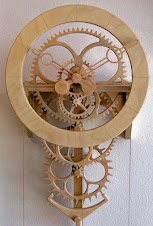FOR A CLOCK THAT RUNS TOO SLOW...(but also be sure to read over the section below on "For a clock that runs too fast").
If you have recently finished your clock and put it into beat and it's running too slowly - I recommend you do nothing for four to six weeks.
Some time ago I got an email from a builder whose Simplicity ran too slowly at first, he cut off the pendulum...only it was too soon. When his clock eventually found its beat, it then ran too fast. I recommend waiting a few weeks before shortening a pendulum shaft because it is much easier to cut off a pendulum than to add to it.
Some clocks need to run a while before they find their "beat". It is best to simply watch a new clock for a few weeks. Stand back and enjoy viewing its motion, and congratulate yourself for getting a chunk of wood to move. Just enjoy the movement.
If your clock still runs too slowly after it has run for a few weeks, then you can begin to shorten the pendulum's shaft a little at a time, until you get your clock running at the perfect beat.
But even before cutting off the pendulum, I would recommend that you read over the "Depthing" procedure in my Troubleshooting Blog posts and in my FAQ's, and follow those instructions. Depthing will help to free up any residual internal friction in your clock and possibly make it run more freely. The links to my Blog and FAQ's is at the bottom of my main page.
You can also add just a slight bit of paraffin to the tooth contact surfaces where the pinion and wheel teeth touch. Add just a very slight amount - because too much paraffin can clog the dedendum and make the clock stop. Candle wax works okay, but I like to use a color coordinated Crayon. Crayon paraffin is softer than candle wax, and that sharp point makes getting between the teeth much simpler.
You can also remove the pallets, wind your clock, and let the gears run free. When the wheels stop, rewind the clock and let it run free again a few times. Things get spinning pretty fast! But sometimes this helps to "break in" the mechanism more quickly.
If/when you have done all of the above suggestions and your clock is still running too slowly with the bob all the way up as high as it will go on the pendulum; to determine how much of the pendulum to cut off you can measure the threaded rod sticking out the bottom of the bob, and remove about half that length from the pendulum's shaft...but be sure to wait a few weeks before cutting the pendulum to give your clock time to 'break in' and find its beat.
FOR A CLOCK THAT RUNS TOO FAST...(but also read "For a clock that runs too slow" above.)
If you have just put your clock into beat, leave all alone and just enjoy the movement for four to six weeks. Some clocks run fast, others too slowly when first put into beat and they require a "break in" period to find their beat. I recommend during this time to just stand proudly in front of your clock and pat yourself on the back for doing such a good job of getting a chunk of wood to move.
After the break in period if your clock is still running too fast (and it depends upon how fast) two things may be happening. If your clock is gaining minutes a day, you can try to simply make the bob heavier, and/or lengthen the pendulum by a few inches. If your clock is gaining hours a day, something is probably slipping inside the clock's train and you'll need to investigate further to find the broken, unglued, or unrestrained part.
Certain escapements, like the Graham, are not very sensitive to drive weight, but others, like the grasshoppers and the "walking" on the HO, and the verge and foliot on the Wee Willie and Horologium are quite sensitive to drive weight. If your clock is running fast, try to decrease the amount of drive weight. Also read the section on "Depthing" on my site in my FAQ's and the four informative Troubleshooting posts in my Blog. The links to these can be found at the bottom of my main page.
As I mentioned, if you just put your clock into beat, it is best to not do anything for a few weeks except enjoy the movement. After that time you'll want to check the bob weight by adding fish weights evenly on each side of the bob, and/or increase the pendulum's length depending upon how fast the clock is running.
Take a look at my Attempt for an easy way to add length to a pendulum.
Also, you'll want to do all of this where the clock will actually be permanently mounted. It's weird, but sometimes just moving the clock from the shop to the house can cause the clock to run faster or slower (I have no explanation as to why, but it has happened a few times to my own clocks).
Enjoy!
Aloha. Clayton

